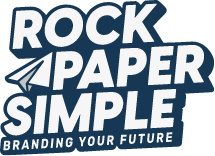
So what is “lead capture” anyways?
It’s the bulls-eye of your website! In almost every case, if your website is generating leads, it’s doing it’s job!
The whole purpose behind any method of website lead capture is to capture a prospect’s information in some form or another. This could be a sales lead in which they are asking about your services, it could be their email address so that you can continue to market to them, a social follow so they can remain exposed to your marketing or any other form of lead or connection. It is pretty common for websites to just provide information, but no real lead capture opportunities. Without lead capture, how will we convert visitors into leads and more sales?! We won’t… and that is why lead capture is one of the key elements behind a results-focused website.
Think about it… warm leads from people already interested in what you have to offer sounds much better than cold-calling or bulk-mailing tons of people who might not even need what you have to sell, huh? You will hear it from any good internet marketer, the money is in your list. If you have a solid list of prospects to market to, you will make more money. Making great use of lead capture methods on your website will help convert traffic into leads.
Start with excellent content
You will need to make sure you start by creating excellent content for your website that presents the benefits of working with you and what you have to offer them. I have some great colleagues who are internet marketing coaches and one of the things they tell their clients is that the purpose of each line of copy is to get the reader to read the next line. It’s so true! Your content should guide the visitor through your page and ultimately end on some sort of lead capture.
[sws_pullquote_left] “Your content should guide the visitor through your page and ultimately end on some sort of lead capture.” [/sws_pullquote_left]
You need to write with your visitor in mind and get them excited so they WANT to take action with one of our website lead capture methods. Your content will be a key determining factor in if they find value in your offering and if they feel safe providing you with their information.
Now on to the fun part. Let’s chat about some of the actual lead capture methods you can use.
#1. Contact forms
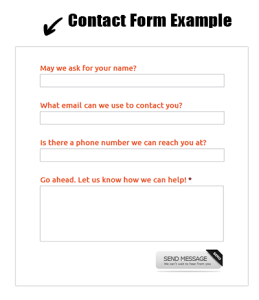
This method is going to actually be expected by most visitors and people are used to seeing it, but at the same time it isn’t terribly attractive and does not create a lot of value or incentive. We use this method on our Contact Us page as a simple contact method should someone go directly to that page and as an option on some of our sales pages, however we use more advanced methods elsewhere on the site.
(psst… always avoid using the word “submit” on forms)
#2. Freebie form
This method is an evolution of the contact form. The reason it works so well is that it first creates an incentive and added-value to a visitor completing it before requesting their information. You are essentially saying “if you fill out this form, I will give you something for free in exchange”. The goal behind this is to create something of value that your visitor absolutely must have and that will incite them to give you their contact information for. This could be an eBook, report, whitepaper, audio, video or even a sampler kit you mail them. The freebie you choose should be something they see value in and will want enough to fill out your form.
The most common delivery method is to provide the form and setup an autoresponder that automatically emails the download link to the visitor who fills out the form. A thank you page for the form can also be setup for this purpose. I highly suggest using a third party system to capture the email and automate the sending of the email with a link to the freebie as well as a tool to be able to follow up with an email newsletter. Some of the better systems include InfusionSoft and 1ShoppingCart which provide form codes to embed on your website that will capture the email, add it to a list, send out autoresponders and ongoing email newsletters. You can also use Mail Chimp or Constant Contact, but they are more geared towards just sending newsletters and have less autoresponder options.
Again, keep it simple and only ask for the information you need. In most cases, for a freebie, you are only going to ask for a name and email and in the case you are mailing them something, a mailing address. You will notice we have a freebie form through-out our website on various pages. You can also find a page on our website dedicated to capturing leads through our freebie form.

#3. Schedule a call button
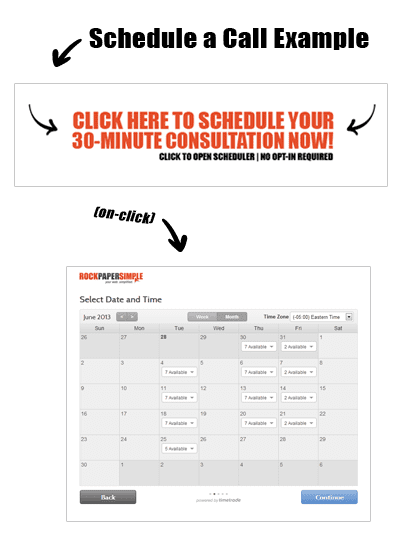
This is a great lead capture method (one of my favorites!) that places a button on your website, normally within your content or as a home page call to action that opens up a calender with available times for the visitor to choose from and schedule a phone call with you. This is powerful because it not only captures the lead, but you have more than just their contact information, you have a scheduled call! We use this method throughout our website and in fact you will find one at the bottom of this blog post.
Be sure to create value and incentive for them to take action. For example we offer a “free 30-minute consultation” and when they click on the button, they are taken to the scheduler to choose when they want to call us. We also tell them exactly what is going to happen to them on the button by including “click to open scheduler | no opt-in required”.
I highly recommend using a company called TimeTrade for this functionality. It is very affordable and provides you with the tools to setup the scheduler, customize it with your information, choose the time slots you want open, integrate it with your Google Calendar and provides you with the link to attach to your button on your website.
#4. RSS feed
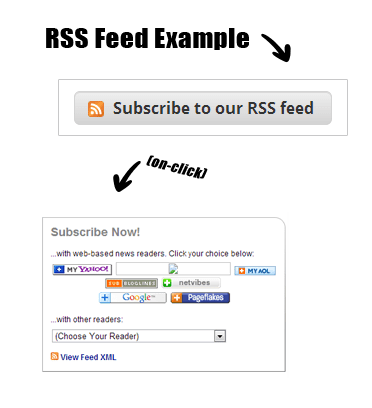 As funny as this is going to sound (we are not making this up, I promise!), the term RSS stands for Really Simple Syndication. “Ok, cool, so it has a funny name, but, what is it”? Well, here’s the Simple version: It is a really easy way to send out content so programs and other websites can read it.
As funny as this is going to sound (we are not making this up, I promise!), the term RSS stands for Really Simple Syndication. “Ok, cool, so it has a funny name, but, what is it”? Well, here’s the Simple version: It is a really easy way to send out content so programs and other websites can read it.
This makes it super easy for people to use RSS readers to pull in all the feeds from all the blogs, news sites and other websites they are interested in. WordPress websites automatically generate RSS feeds of your blog posts, so if you have a WordPress website you just need to know how to provide that link to your visitors so they can subscribe to it using their favorite reader. By getting people to subscribe to your feed, it is almost as good as capturing their email for your newsletter because they regularly see your new content.
We use Feedburner to manage our feed since it provides additional options and statistics for us and should we ever change our blog URL, we can move our subscribers along with us instead of losing them. You will find that we provide an RSS button in our footer as well as at the bottom of our blog page and individual blog posts.
#5. Social media like or follow
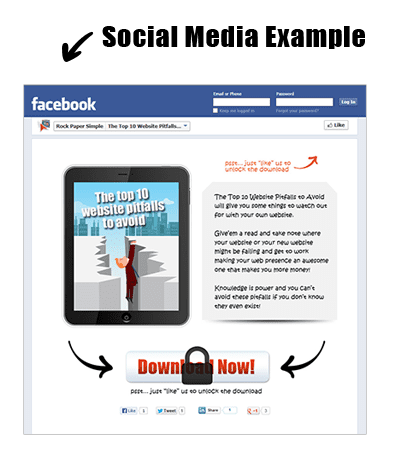 While a little more passive than some of the other methods providing ways for visitors to “like” your Facebook fan page or “follow” your Twitter account still exposes them to your ongoing marketing and provides a way for them to engage with you. This, of course, hinges on the assumption that you are posting regularly on your social media presences. Integrating a Facebook “like” button or a Twitter “follow” button is pretty simple and should be placed in positions that make sense to visitors. Communicate what the benefits are for them to connect with you so they know what to expect.
While a little more passive than some of the other methods providing ways for visitors to “like” your Facebook fan page or “follow” your Twitter account still exposes them to your ongoing marketing and provides a way for them to engage with you. This, of course, hinges on the assumption that you are posting regularly on your social media presences. Integrating a Facebook “like” button or a Twitter “follow” button is pretty simple and should be placed in positions that make sense to visitors. Communicate what the benefits are for them to connect with you so they know what to expect.
There are also tools and methods available to “lock” content until someone “likes” it or shares it in some fashion via social media channels. This advanced technique is very similar to the freebie above and in fact can be done in conjunction with a freebie. You promise your visitors additional content or a freebie in exchange for a social interaction.
For example, we have a landing page on our Facebook fan page that requires a “like” to download our freebie as incentive.
#6. Honorary Retro Mention: Newsletter Opt-in form
While still something that we use on some of our clients websites from time to time, it’s not something we use very often any more and I’ll explain why.
As another iteration of the contact form, the opt-in form requests the visitor provide their name and email (or just email) to be included on your email newsletter list. While nowhere near as effective as a freebie form, this will allow visitors who are interested in what you have to say to provide their contact information in exchange for it sent to them on a regular basis.
This method can work to garner some leads, but don’t expect hordes of people to give away their email addresses just to receive MORE email in their box each week. If you are going to be capturing emails for your newsletter, tie it into a freebie so you create more value. If you must place a newsletter capture form, place it in your footer or at the bottom of your blog posts. On some occasions when a client has a particularly valuable newsletter, it may be placed in the header.
When using any kind of lead capture method, keep these things in mind:
- Keep it simple! Don’t ask for alot of information. Always ask for the absolute least amount of information you can. That means that if all you need is name and email, that’s all you ask for. Other common fields to include are the phone number and a field for their message. Beyond that, if you don’t need it to make contact, don’t ask for it. I’ve seen lots of forms that ask for tons of information such as address, gender, multiple service questions, etc. People are much more likely to fill out a form that asks for less things.
- Tell people what to expect. Your visitors will always appreciate being told what is going to happen. What is next after they fill out the form? Will they get spammed? Will you email them? Will you call them? What is next? Use some pointed content to assure them what is coming. This could be something as simple as “Use the form below to request your FREE 30-minute consultation and we will call you within 24 hours”.
- Make it look trustworthy. You are asking people to share personal contact information, make sure the form or button (and the whole site for that matter) looks like they can trust it. That means spend a little time making sure it is easy to read, text is lined up properly and everything is spaced out appropriately.
So, now what are you going to do about it?
 So you see how important lead capture is to a results-based website and you’ve even learned about five or six methods… so what are you going to do about it? Take action! Make sure you are incorporating at least one or two of these on your website so you aren’t wasting traffic to your website.
So you see how important lead capture is to a results-based website and you’ve even learned about five or six methods… so what are you going to do about it? Take action! Make sure you are incorporating at least one or two of these on your website so you aren’t wasting traffic to your website.
All the information you can learn won’t help your website make you more money unless you apply it. So I encourage you, pick one or two of these and apply them to your website so you can start converting that traffic to leads and ultimately sales!
